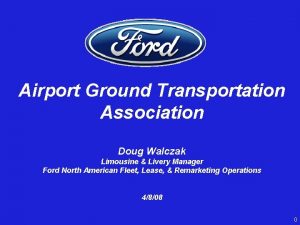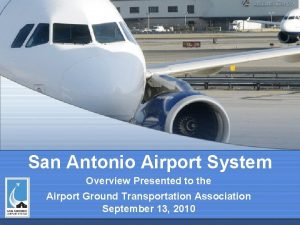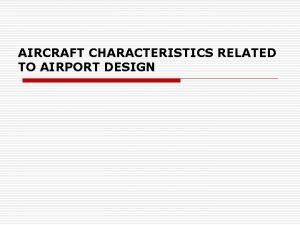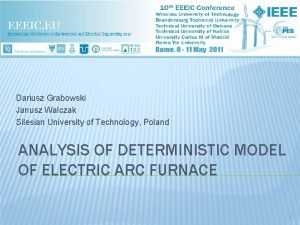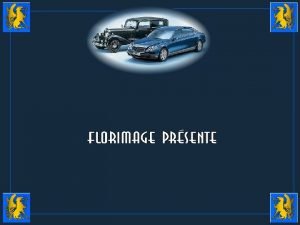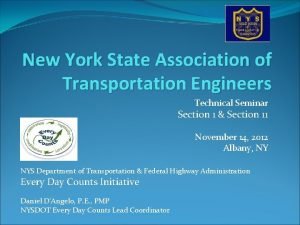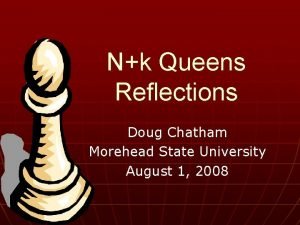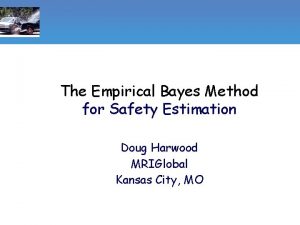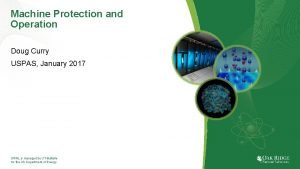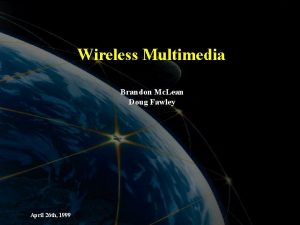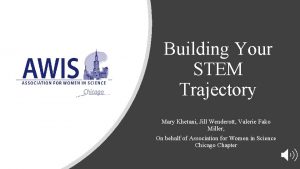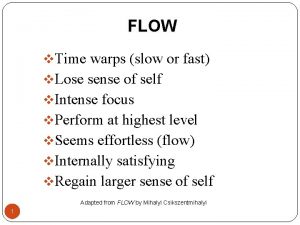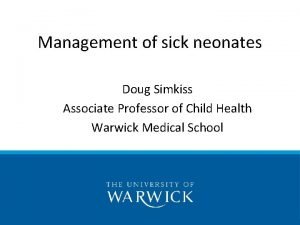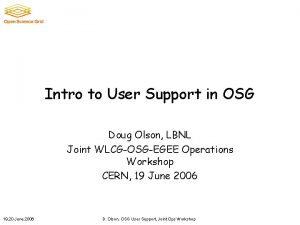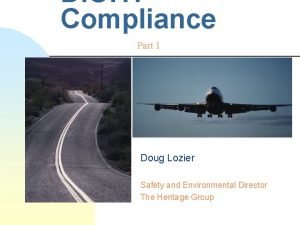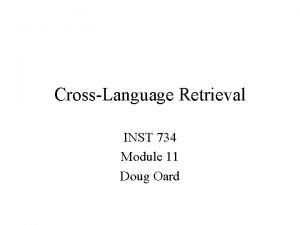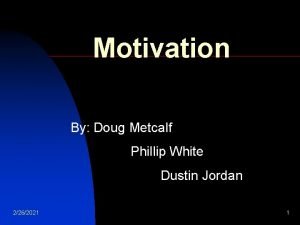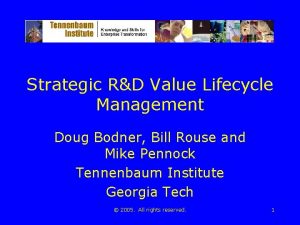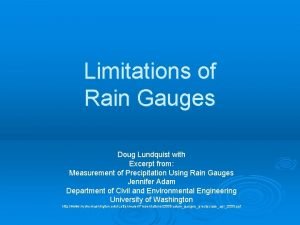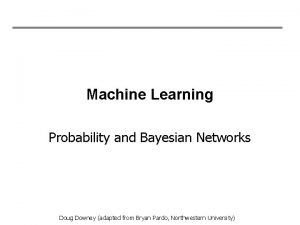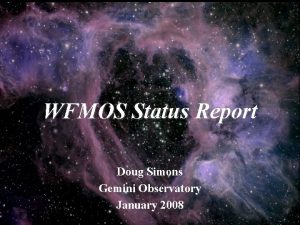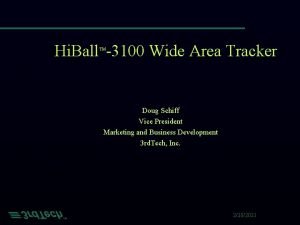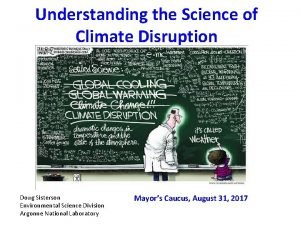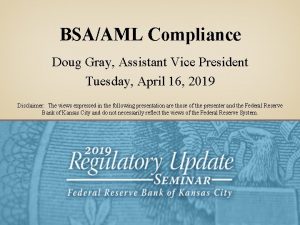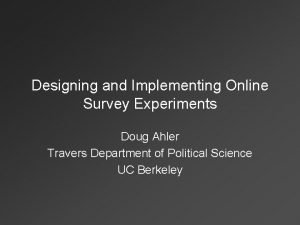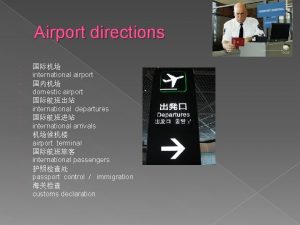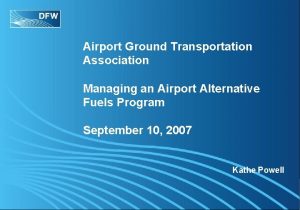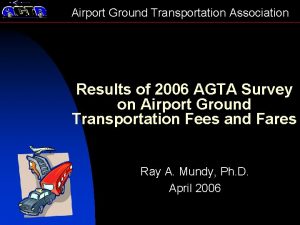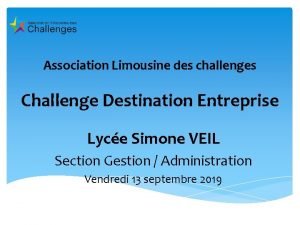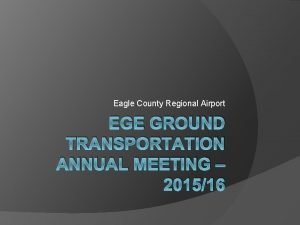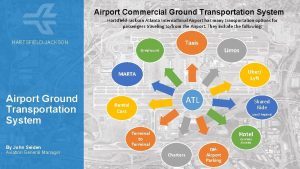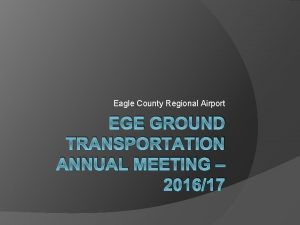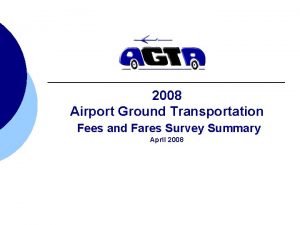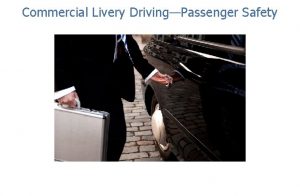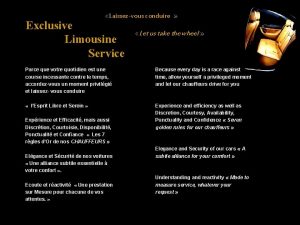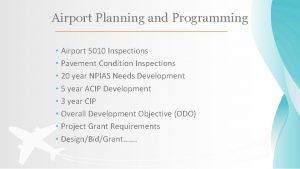Airport Ground Transportation Association Doug Walczak Limousine Livery









































- Slides: 41

Airport Ground Transportation Association Doug Walczak Limousine & Livery Manager Ford North American Fleet, Lease, & Remarketing Operations 4/8/08 0

External Factors have Triggered Increased Environmental Focus s e c ri p d l i n O a h m g e i D H t y u h C W en't Hav …CO is dow n 62% 52% a , SO 2 nd NO is dow x i s down n gas po 2 wered 4 vehic % in les Energy Bill won’t wean US off of oil imports Bush Se eks to “ Break Addictio n” to Fo reign Oi l What is the impact on your company? 1

Questions for You 1. What is your company’s environmental objective? n n n • If alternative fuels are the focus…. . Is it to meet regulatory requirements or to modify your existing fuel policy? If emissions compliance is the focus……. is it a reduction in Greenhouse Gas (CO 2)? Is it to promote a corporate environmental image? How does your vehicle fleet play a role in achieving your company’s objective? 2

Becoming Environmentally Friendly What you ask for Clean Air Global Warming/ Sustainability What It Means Tailpipe Emissions of NMOG/HC. Low EVAP of HC Reduction of fossil fuels & reducing CO 2 to a sustainable level using renewable fuels Energy Independence Fuel Economy Conservation & reduction of petroleum based fuels Increased mileage capability / gallon gas b Ethanol Operation PZEV Emissions ICE Gas Technology d c c Diesel Operation Hybrid Operation a A) Hybrid with PZEV operation (AT-PZEV) B) Improves as you move from “corn” based to cellulosic C) Improves with long term move to bio-diesel D Coupled with PZEV emissions operation 3

n Leverage a flexible array of technology options including Hybrids, Clean Diesels, Bio-diesel and Ethanol n Advance research on Lithium battery hybrids, H 2 ICE and Fuel Cell technology n Customers will decide what technology best suits their needs for the future

Powertrain Technologies – Timeline 100 x Cost Today Fuel Cell FE % 90 - Hydrogen I. C. E. Specific Benefit 5 x Cost 3 x Cost 1. 5 x Cost FE % 20 - 25 Hybrid Powertrain FE % 5 - 45 Diesel I. C. E. FE % 25 – 35 1. 01 x Cost Flexible Fuel Engines FE % (15) – (25) / >500% 1. 2 x Cost Advanced Gasoline I. C. E. FE % 15 - 20 Near Term Mid Term Deployment Timeframe Long Term 5

Pathway to the Future: Advanced Technology Fuel Cells Hydrogen Powered Internal Combustion Engines Hydrogen Internal Combustion Engines: Bridging technology • Bridging action / enabler for H 2 Economy • H 2 emissions benefits realized in near term Hybrid Powertrains (Including Plug-Ins) Hybrid Powertrain: 10 -15% Market Hybrid Powertrain: 10 • Market driven niche solution • Benefits realized in urban driving conditions Modern Clean Diesels (Including Biodiesel Modern Clean Diesel: Core for next 40+ yrs • Challenges – fuel quality, Tailpipe Emissions standards Gasoline Engine Efficiency: Core for 30+ yrs • Low cost, reliable, familiar • Existing capital & refueling infrastructure Advanced Gasoline Internal Combustion Engines (ICE) (Including Biofuels) Near Term Fuel Cell: Impact in 20 -30 yrs • Endgame for the hydrogen economy • Environmentally neutral powertrain Mid Term Long Term 6

Advanced Gasoline Engines Benefits Challenges Key Facts n Reliable and familiar n Fuel economy to consumers n Compatible with ethanol fuel blends up to 10% n U. S. gas prices relatively low compared to other markets n Approaching near -zero emissions tradeoffs required to comply with increasingly stringent emissions and safety standards n Cost effectiveness of incremental technologies n Incremental improvements in efficiency are being achieved via: Six Speed Transmissions, Variable Displacement Engines, Direct Injection, Variable Cam Timing, Variable Compression Ratios 7

Eco. Boost Engine Technology § Eco. Boost – Ford Motor Company’s new high-volume engine technology: o uses gasoline turbocharged direct-injection for up to 20% better fuel economy and 15% fewer CO 2 emissions § Available in half a million vehicles during the next five years beginning with the new Lincoln MKS sedan in 2009 o 3. 5 L twin-turbocharged V-6 delivering power (340 hp) and torque (340 lb. ft. ) of a V-8 with the fuel efficiency of a V-6 § Real-world fuel economy benefit is achieved in all drive cycles – city and highway 8

A Pathway for Today: Ethanol (E 85) ● Ethanol has been a transportation alternative fuel choice for more than 10 years ● About 4. 9 billion gallons of ethanol were produced for transportation purposes in 2006 ● Most U. S. ethanol is currently derived from corn ● Ethanol produced from cellulosic feedstocks planned for the future 9

Why Ethanol Now? Opportunity for Immediate Impact • Ford has placed over 2 million E 85 FFVs on America’s roads • As a whole, U. S. automakers have produced more than 6 million E 85 flexible fuel vehicles • If all of these vehicles were operated on E 85, over 3. 6 billion gallons of gasoline a year could be displaced. üThat’s like saving a full year of gasoline consumption in a state like Missouri or Tennessee. • Ford, GM and Daimler. Chrysler voluntarily committed to doubling our production of FFVs by 2010. üWe expanded that commitment to include half our vehicles each year by 2012, provided sufficient infrastructure is in place 10

E 85 Flex Fuel Benefits Challenges Key Facts n Promotes U. S. n Limited fuel energy security and fuel diversity n Agricultural-based renewable fuel n Offers fuel flexibility for customers n Incremental cost absorbed by Ford infrastructure n Fuel cost vs. gasoline – 20% price differential needed n Customer acceptance of fuel n Fuel system components more expensive than gasoline n Over 6 million E 85 FFVs on the road today in the U. S. n About 1, 100 E 85 stations in the U. S. n The 5. 4 L F-Series is Ford’s latest FFV 11

What Is Needed? More E 85 Stations Will Solve The “Chicken & Egg” Problem E 85 Availability Primarily in the Midwest (presently about 1, 100 stations – out of about 170, 000 retail gasoline stations nationwide) 12

Ethanol Vehicle Availability (E 85) §Three new products - Crown Victoria Police, Taxi and E-Series § 50 State Certification on F-150, Crown Victoria, Grand Marquis §New Yellow Gas Cap highlighting E-85 capability 16

Pathway to the Future: Advanced Technology Fuel Cells Hydrogen Powered Internal Combustion Engines Hydrogen Internal Combustion Engines: Bridging technology • Bridging action / enabler for H 2 Economy • H 2 emissions benefits realized in near term Hybrid Powertrains (Including Plug-Ins) Hybrid Powertrain: 10 -15% Market Hybrid Powertrain: 10 • Market driven niche solution • Benefits realized in urban driving conditions Modern Clean Diesels (Including Biodiesel Modern Clean Diesel: Core for next 40+ yrs • Challenges – fuel quality, Tailpipe Emissions standards Gasoline Engine Efficiency: Core for 30+ yrs • Low cost, reliable, familiar • Existing capital & refueling infrastructure Advanced Gasoline Internal Combustion Engines (ICE) (Including Biofuels) Near Term Fuel Cell: Impact in 20 -30 yrs • Endgame for the hydrogen economy • Environmentally neutral powertrain Mid Term Long Term 17

Advanced Technology Diesel Benefits Challenges Key Facts n Significant increase n Lingering public in fuel economy (20 -30%) n Higher performance, less noise, less odor n Improved emissions n Ample refueling infrastructure perception n Meeting stringent U. S. emission standards n Fuel quality improvements (low sulfur, cetane) n Higher incremental cost for vehicle and fuel n All Ford diesel applications can use 5% biodiesel blends n Low Nitrous Oxides (NOx) levels may be achieved with urea cofueling 18

B-20 Applications • All New 6. 4 L Diesel launched with the 2008 MY Super Duty • Ford Powertrain Engineering presently developing B-20 capabilities • Working with Fuel partners on development of B-20 specification • Pilot Demonstrator Program is in development 19

Pathway to the Future: Advanced Technology Fuel Cells Hydrogen Powered Internal Combustion Engines Hydrogen Internal Combustion Engines: Bridging technology • Bridging action / enabler for H 2 Economy • H 2 emissions benefits realized in near term Hybrid Powertrains (Including Plug-Ins) Hybrid Powertrain: 10 -15% Market Hybrid Powertrain: 10 • Market driven niche solution • Benefits realized in urban driving conditions Modern Clean Diesels (Including Biodiesel Modern Clean Diesel: Core for next 40+ yrs • Challenges – fuel quality, Tailpipe Emissions standards Gasoline Engine Efficiency: Core for 30+ yrs • Low cost, reliable, familiar • Existing capital & refueling infrastructure Advanced Gasoline Internal Combustion Engines (ICE) (Including Biofuels) Near Term Fuel Cell: Impact in 20 -30 yrs • Endgame for the hydrogen economy • Environmentally neutral powertrain Mid Term Long Term 20

Hybrid Electric Benefits n Significant increases in fuel economy (full hybrids) n Uses existing fueling infrastructure n Can achieve near zero emission levels n Full-hybrid technology is most effective in city and stop-and-go driving Challenges Key Facts n Incremental cost for n Wide variety of hybrid option n Limited U. S. supply base for battery technology n Applications to broader vehicle segments (i. e. trucks, larger SUVs, etc. ) n Customer acceptance/ value technologies exist across the industry (mild to full) n Ford delivered 20 HEV-FFV demo vehicles this spring 21

Ford’s “Family of Hybrids” Ford Escape & Mercury Mariner • Available now Ford Fusion & Mercury Milan Production beginning in 2008 CY 22

Escape Hybrid Taxi n Ford Escape Hybrid Taxi has received overwhelming positive press and awareness as a result of its successful fleet application o USA Today – San Francisco Taxi o CNN – New York Escape Hybrid Taxi 23

Hybrid Taxi Fleet n Current Fleet – 328 vehicles n Taxi Locations – San Francisco – New York City Feb 2005 (40) Nov 2005 (288) n Annual Vehicle Environmental Benefits* � Savings of 1, 666 gallons of gasoline � Removal of 32, 000 lbs of carbon emissions FWD Escape rated at 36 mpg in city driving & provides 500 miles to a tank n Vehicle Durability – Up to 200, 000 miles, San Francisco n Driver Benefits – Taxi Drivers save up to $30 / shift or more than $6, 000 annually in fuel Ford holds more than 150 patents on the Hybrid Escape * Annual savings based upon San Francisco experience of 100, 000 miles per year. 24

Escape Hybrid E-85 Demonstration Fleet n Demonstration program marrying two petroleum-saving technologies – hybrid electric and flex fuel n 20 vehicles delivered for real world testing and engineering evaluation n Helps reduce dependence on imported oil n Produces about 25% less carbon dioxide than a gasolinefueled Escape Hybrid 25

Hybrid E-Series Commercial Chassis n E-Series strip chassis n Parallel Hybrid design using the 5. 4 L 5 R 110 Powertrain n All development and integration done by Azure Dynamics n Electric motor in drive train providing regenerative braking plus additional start up power. Engine off capability and limited full electric mode operation also provided. 26

Plug-in Hybrids Benefits Challenges n Breakthrough fuel n High cost of battery economy improvements for customers with 20 -40 miles daily use n Off-peak electric charging provides lowcost power opportunity n Interconnectivity with home/business power system can offset peak load costs storage systems (2 -3 x hybrid systems) requires new business model involving wind, utilities, renewable fuel providers and policy makers n Battery must complement stationary applications to ensure high residual value after vehicle use Key Facts n Ford and Southern California Edison collaborating on industry first demo program n Ford to deliver small fleet of vehicles for testing n High-density lithium ion battery cost exceeds $15, 000; long-life characteristics can support vehicle and post-vehicle energy storage applications 27

Pathway to the Future: Advanced Technology Fuel Cells Hydrogen Powered Internal Combustion Engines Hydrogen Internal Combustion Engines: Bridging technology • Bridging action / enabler for H 2 Economy • H 2 emissions benefits realized in near term Hybrid Powertrains (Including Plug-Ins) Hybrid Powertrain: 10 -15% Market Hybrid Powertrain: 10 • Market driven niche solution • Benefits realized in urban driving conditions Modern Clean Diesels (Including Biodiesel Modern Clean Diesel: Core for next 40+ yrs • Challenges – fuel quality, Tailpipe Emissions standards Gasoline Engine Efficiency: Core for 30+ yrs • Low cost, reliable, familiar • Existing capital & refueling infrastructure Advanced Gasoline Internal Combustion Engines (ICE) (Including Biofuels) Near Term Fuel Cell: Impact in 20 -30 yrs • Endgame for the hydrogen economy • Environmentally neutral powertrain Mid Term Long Term 28

Hydrogen Powered Internal Combustion Engines (H 2 ICEs) ü Key “Bridge” Technology ü H 2 ICE Shuttle Bus Demonstration w/6. 8 L Supercharged H 2 Triton V 10 ü Holds up to 12 passengers plus luggage ü Worked with State of Florida, Dallas. Ft. Worth airport, Canadian government and others to launch a demo fleet 29

Pathway to the Future: Advanced Technology Fuel Cells Hydrogen Powered Internal Combustion Engines Hydrogen Internal Combustion Engines: Bridging technology • Bridging action / enabler for H 2 Economy • H 2 emissions benefits realized in near term Hybrid Powertrains (Including Plug-Ins) Hybrid Powertrain: 10 -15% Market Hybrid Powertrain: 10 • Market driven niche solution • Benefits realized in urban driving conditions Modern Clean Diesels (Including Biodiesel Modern Clean Diesel: Core for next 40+ yrs • Challenges – fuel quality, Tailpipe Emissions standards Gasoline Engine Efficiency: Core for 30+ yrs • Low cost, reliable, familiar • Existing capital & refueling infrastructure Advanced Gasoline Internal Combustion Engines (ICE) (Including Biofuels) Near Term Fuel Cell: Impact in 20 -30 yrs • Endgame for the hydrogen economy • Environmentally neutral powertrain Mid Term Long Term 30

Fuel Cell Benefits Challenges Key Facts n Zero Emission n High cost of Vehicle (ZEV) n Breakthrough performance in energy efficiency n Hydrogen can be derived from multiple sources n Promotes long-term renewable fuel vision technology n On-board hydrogen fuel storage n Hydrogen infrastructure is in its infancy n Lack of uniform codes and standards n DOE demonstration projects are under way n Significant volume applications are not expected before 2030+ 31

Edge Hy. Series Drive Hybrid n First drivable fuel cell HEV with plug- in capability n Operates using a fuel cell, small gasoline or diesel engine connected to an electric generator n Powered by a 336 -volt lithium-ion battery pack (refreshed by an onboard charger from a standard home outlet) n Drives first 25 miles on stored electricty, after which the fuel cell kicks in to keep battery charged (provide additional 200 miles range 32

Environmental Interiors § First U. S. automotive application of seating surfaces made from 100% postindustrial materials. Positive benefits include: o Estimated conservation of 600, 000 gallons of water o 1. 8 million pounds of carbon dioxide equivalents o More than 7 million kilowatt hours of electricity annually § Soy foam technology launched in the Mustang seat cushions and seat backs o Potential to replace up to 30 pounds of petroleum based foam used today 33

Easy. Fuel – Capless Fuel Fill Technology n Industry exclusive feature n Eliminates the need for a fuel cap speeding up the refueling process n Provides a better seal than a fuel cap which reduces the escape of smogproducing emissions n Eliminates annoying false “Check Engine” light 34

Eco-Friendly Paint • Industry-first paint technology that is better for the environment • Combines an advanced chemical formulation of high solids, solvent borne paint with innovative three-part wet application process • Reduces CO 2 emissions by 15% & Volatile Organic Compounds (VOC) emissions by 10% • Ford won “Best Technical Prize” for the new paint technology at the International Conference on Automobile Body Finishing 35

Environmental Manufacturing Ford Rouge Manufacturing Plant n Worlds largest living roof n Controls storm water run-off n Cools the plant in the summer n Lasts longer than a conventional roof n Never needs to be mowed 36

2008 Mariner Hybrid Livery Package 37

Livery Package Option Code 47 L Mariner Hybrid Livery Package: n Heated front seats n Premium leather seating surfaces n Lumbar controls n Energy Flow Navigation system n Reverse Sensing System n Roof rack with satin inserts & black cross bars n Heated mirrors n Body-color exterior mirrors n Cargo area cover n 110 V AC power outlet n 4 -year/100, 000 mile Extra. Care ESP for livery vehicles 38

Full Hybrid A full hybrid operates in four functional states: 1) Automatic gas engine start/stop 2) Full regenerative braking 3) Full electric launch and drive 4) Electric assist n A full hybrid has a larger, more powerful battery pack and can be powered entirely by electric power. n A mild hybrid is essentially gasoline-powered, using the electric motor only to assist the gas engine as needed. n Full hybrids also take advantage of the efficiencies of hybrid technology by: – Recharging the batteries during braking (full regenerative braking) – Moving the vehicle solely by electric power n Full hybrids are more efficient than mild hybrids, which do not employ full regenerative braking or electric-only operation 39

Competitive System Overview Mild vs. Full Hybirds Electric Motors Metro. Hwy Fuel Economy Benefit Hybrid Function / Benefits HEV Type Battery Size Starter/ Generator Drive e. AWD Regen. Braking Start/ Stop Electric Launch Electric Only Mode Saturn VUE HEV Mild 36 V 4 k. W - - Minimal Y N Brief 20%1 Medium 144 V 12 k. W 4 - - Y Y N N 30% Toyota Prius Full 201. 6 V 29 k. W Estimate 2 50 k. W - Y Y NA 3 Toyota Camry HEV Full 244. 8 V 75 k. W estimate 2 105 k. W - Y Y 43% Toyota Highlander Lexus 400 H HEV Full 288 V 78 k. W estimate 2 123 k. W 50 k. W Y Y 45% Ford Escape HEV Mercury Mariner HEV Mazda Tribute HEV Full 330 V 45 k. W 70 k. W - Y Y 42% Honda Accord 1 2 3 4 Saturn VUE HEV 20% FE benefit – approximately 5% is from BISG HEV, while approximately 15% are from other vehicle actions (aero, engine actions - 2. 2 I 4 to 2. 4 VVT I 4, DFSO, FDR, weight, others) Toyota does not publish starter/generator motor values, therefore these numbers are estimates based upon battery and drive motor size. Toyota Prius does not have an equivalent gasoline vehicle, so the fuel economy percent benefit cannot be determined. Honda Accord electric motor provides starter, generator, and electric boost (supplemental torque) functions, but cannot operate alone without the gasoline engine. 40

Key Comparison Data VEHICLE LINE: 2007 Toyota Prius 2008 Mariner Hybrid Mechanical Gas 76 hp @ 5000 rpm 133 hp @ 6000 rpm 67 hp @ 1200 -1540 rpm 94 hp @ 5000 rpm Hybrid System Net Power 110 hp (82 k. W) 155 EPA Estimated MPG (C/H) 60/51 34/30 Electric Key Specifications Passenger Volume 96. 2 99. 4 Cargo Capacity 14. 4 29. 2 41

Tax Credits For 2008 MY, Escape and Mariner Hybrid tax credits have increased due to improvements in real world fuel economy n FWD: $2600 $3, 000 n 4 WD: $1950 $2, 200 Mariner now has the highest Hybrid tax credit of ANY vehicle 42

Thank You! 43
 Airport ground transportation association
Airport ground transportation association San antonio airport ground transportation
San antonio airport ground transportation Aircraft length
Aircraft length Dariusz walczak md
Dariusz walczak md Kasia kamuda
Kasia kamuda Hereford govedo
Hereford govedo La voiture la plus luxueuse du monde
La voiture la plus luxueuse du monde Donnez moi une suite au ritz
Donnez moi une suite au ritz New york state association of transportation engineers
New york state association of transportation engineers Land navigation azimuth
Land navigation azimuth Doug morehead
Doug morehead Codename sr
Codename sr Doug eberhart
Doug eberhart Doug harwood
Doug harwood Doug curry
Doug curry Doug fawley
Doug fawley Jill wenderott
Jill wenderott Doug yakola
Doug yakola Doug newburg
Doug newburg Doug tischer
Doug tischer Doug simkiss
Doug simkiss Doug olson cms
Doug olson cms Doug long iqvia
Doug long iqvia Doug lozier
Doug lozier Doug oard
Doug oard Doug kirchner
Doug kirchner Doug metcalf
Doug metcalf Doug bodner
Doug bodner Doug coil machine
Doug coil machine Doug feery barrister
Doug feery barrister Doug lundquist
Doug lundquist Doug heckman
Doug heckman Rob hall character analysis
Rob hall character analysis Doug downey northwestern
Doug downey northwestern Doug simons
Doug simons Ccg consulting doug dawson
Ccg consulting doug dawson Doug schiff
Doug schiff Doug
Doug Doug gray scott
Doug gray scott Protophysics
Protophysics Doug ahler
Doug ahler Doug fiedler
Doug fiedler
